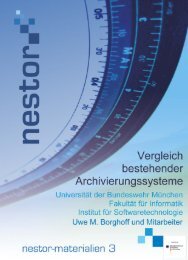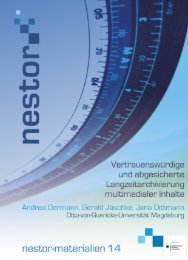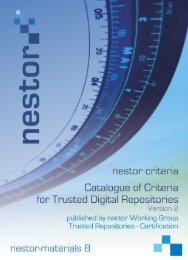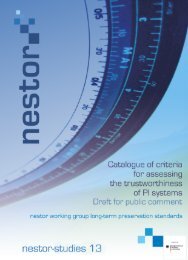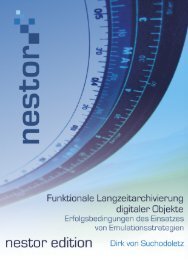help of JHOVE. In this context, the question remains at which point the SIPs will becreated and at which point format characterization and validation will hence be carried out.A possible scenario according to Dr. Kluge is that koLibRI will create SIPs twice a month.In establishing this routine it will be crucial to consider how <strong>file</strong>s submitted to Qucosa willbe treated in the time between submission by the depositors and their processing bykoLibRI. For example, it has to be considered whether it is advisable to make these <strong>file</strong>spublicly accessible through Qucosa before their integrity was checked by JHOVE. Thus, ifan error is detected by JHOVE, it might be easier to correct it – e.g. by replacing the <strong>file</strong> –if it is still unpublished. Any other procedure might lead to conflicts with the DNB's URNpolicy, according to which a new URN has to be assigned if, for example, the MD5checksum of a publication can be shown to have changed (see above).As with pedocs and JUWEL, the “completeness and correctness” of the submitted<strong>file</strong>s is additionally ascertained by means of intellectual control, especially with regard tometadata and the author agreement – thus, no publication takes place until the signedagreement has been received, and Qucosa staff will correct or add metadata before thedigital object is added to the repository. As authors are requested to submit a certainamount of descriptive metadata (e.g. keywords/subject terms) it might be helpful to advisethem – e.g. in the FAQ or publication guidelines – that their submitted metadata will besubject to quality control and may be modified in the process.Authenticity: As authors are not required to identify themselves by creating anaccount, they confirm that they indeed have the right to publish the work in question, andthat hence they are who they claim to be (i.e. the author of a publication) only through theauthor agreement. As mentioned above, this author agreement has to be printed andsigned, and hence exists in analog form. The procedure is therefore different from the onechosen by pedocs, which works with digital agreements (see above).Qucosa does not use secure protocols at the moment so that any information enteredinto the web submission form is submitted in unencrypted form.Ingest: Generate AIPAs in the other two repositories considered here, (pre-)AIPs are created in Qucosa,which will later form the basis for the koLibRI SIPs and the AIPs for long-term archiving.These pre-stage AIPs are saved in the Qucosa <strong>file</strong> system. The information packagescurrently contain a persistent identifier (URN) and a set of descriptive metadata. All in all,the assignment and use of URNs in Qucosa is quite similar to their use in pedocs. Thus,URNs are assigned to the record for the digital object (the so-called “front door”); thedigital object(s) described and referenced by the record is/are addressable via the URLincluded in the record. URNs and URLs are submitted to the DNB, where any changes tothe URL are registered as well. 128 The URN is displayed as preferred form of citation in the128 A considerable number of the URNs are at the moment not resolved and result in a DNB error message(see, for example, http://nbn-resolving.de/urn:nbn:de:bsz:14-qucosa-24790 – 18.10.2009). According toKluge, the problem lies with the DNB, where an interruption of the technical service provided occurred48
ecord for a title; although a workflow exists during which URNs can be integrated into the<strong>PDF</strong>-document (see below), this workflow is not frequently used at the moment so thatonce the publication has been saved or printed by a user, metadata and digital object areseparated. Like pedocs, Qucosa does not record previously assigned persistentidentifiers.Structural metadata: In contrast to the output created by the digitization center atthe SLUB Dresden, the digital objects stored in Qucosa are generally not of a highlycomplex nature and hence do not require extensive structural metadata. However, as theQucosa policy document states, not only “traditional text documents” (which themselves, itshould be noted, may very well have a complex structure), but also multimedia objectsconsisting of sound, image, film, or computer animated elements can now be published inQucosa: “Neben traditionellen Texten können inzwischen auch Multimediadokumente mitTon, Bild, Film, Computeranimation etc. publiziert werden.” 129 Thus it is likely that in thefuture more complex digital objects will be published in the repository, and that structuralmetadata will be required to capture the logical structure of these objects and to make thisstructure understandable for current and (ideally) future users. Already at this point,Qucosa is used to store articles from the SLUB Kurier, a magazine published by the SLUBcontaining information about recent developments and activities in/of the library. While thiscertainly is not a highly complex digital object, and most articles will be understandabletaken by themselves, the use of structural or context metadata to identify articlesbelonging to the same issue and the sequence of articles in the issue would certainly helpto “enabl[e] more efficient navigation of resources” (DPIP 2008). Currently all of thisinformation is available – somewhat implicitly – in the field “source” (“Quelle”), whichincludes information about the magazine issue and article page numbers. However, asthis field cannot be searched individually and can hence only be addressed through thefull text search, this information is not available for the purpose of navigation immediatelyand conveniently.As already outlined in the discussion of pedocs and JUWEL, even if the structure ofjournal or magazine issues is maybe not as relevant in the context of long-termpreservation as other information (e.g. descriptive metadata), to be able to express therelation between different versions or editions of a digital object is crucial. Althoughversioning is according to Kluge not relevant for the materials ingested into Qucosa at themoment, it might become an issue in the future. Thus, as the policy requires that changedobjects are ingested into the repository as new documents, which receive their own URN,the existence of different – e.g. corrected – versions of a publication is very likely in thefuture. As discussed above it will be crucial to identify previous and current versions of adocument, for example, by indicating that object B replaces object A. Otherwise, therelation between similar but not identical objects in the repository might not berecently.129 http://www.qucosa.de/ueber-qucosa/ – 03.11.2009. Hereafter cited as Qucosa Policy.49
- Page 6: AbstractTaking its cue from the inc
- Page 13: and benefit from the development an
- Page 18 and 19: German repositories have already be
- Page 20 and 21: [t]he Open Archival Information Sys
- Page 22 and 23: Thus it seems highly recommendable
- Page 24 and 25: actively pursuing the long-term pre
- Page 26 and 27: Like pedocs, the repository is not
- Page 28 and 29: application for a project grant was
- Page 30 and 31: generating an Archival Information
- Page 32 and 33: Integrity can be defined as “comp
- Page 34 and 35: It is with this step that the metad
- Page 36 and 37: documents submitted to the reposito
- Page 38 and 39: [t]he majority of OCR software supp
- Page 40 and 41: One of the shortcomings of the soft
- Page 42 and 43: set of shared metadata which is the
- Page 44 and 45: document, and that hence the docume
- Page 46: Structural metadata: In DSpace it i
- Page 49 and 50: dc.description.provenancedc.descrip
- Page 51: Für die Langzeitverfügbarkeit der
- Page 55 and 56: Source (where applicable)Publicatio
- Page 57 and 58: checksums. In particular, TRAC requ
- Page 59 and 60: checksums are currently not checked
- Page 61 and 62: 2.4.2 JUWEL Data ManagementThe stru
- Page 63 and 64: Before any SIPs are accepted, the r
- Page 65 and 66: guarantee that documents are “arc
- Page 67 and 68: pedocs is a scholarly open access d
- Page 69 and 70: formats. 151 Although the possible
- Page 71 and 72: While the preferred file format is
- Page 73 and 74: from nestor criterion 8, making it
- Page 75 and 76: preserved for the long term, will h
- Page 77 and 78: It seems that of all three reposito
- Page 79 and 80: associated with them, or has define
- Page 81 and 82: versioning functionality which allo
- Page 83 and 84: communication channels, responsibil
- Page 85 and 86: Works CitedAllinson, Julie (2006):
- Page 87 and 88: DSpace Homepage. http://www.dspace.
- Page 89 and 90: Lynch, Clifford A. (2000): Authenti
- Page 91 and 92: in the EU. Amsterdam: Amsterdam Uni
- Page 93 and 94: Ingestnestor TRAC DINIReceive Submi
- Page 95 and 96: Archival Storagenestor TRAC DINIRec
- Page 97 and 98: Archival Information Update10.4 Das
- Page 99 and 100: Preservation PlanningnestorMonitor



